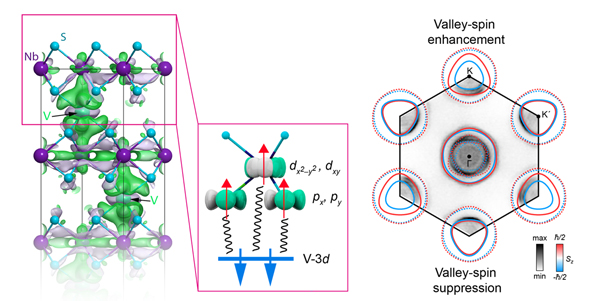An international team of scientists led by Prof Philip King from the University of St Andrews and Dr Mohammad Saeed Bahramy from the University of Manchester has made a major discovery in the field of valleytronics. The research, published in the journal Nature Materials, reveals a giant valley-selective Ising coupling in the surface layer of an intercalated transition metal dichalcogenide, V1/3NbS2, using a combination of state-of-the-art spectroscopy techniques and theoretical modellings performed on the MASAMUNE supercomputer at the Center for Computational Materials Science (CCMS) in collaboration with Associate Prof Rodion Belosludov from Institute for Materials Research, Tohoku University.
Valleytronics is an emerging field in condensed matter physics and materials science that aims to harness the valley degree of freedom of electrons in solids for information processing. By selectively controlling the motion of electrons according to their spin state and energy domain in the momentum space, also known as energy valleys, it is possible to create new types of electronic devices with improved performance and more diverse functionalities.
Probing the surface electronic structure of the semimetal V1/3NbS2 using angle-resolved photoemission spectroscopy measurements, the team discovered an alternating pattern of enhancement and quenching of valley-spin polarization of the host NbS2 layers due to the intercalated Vanadium ions, equivalent to the application of a 250 T magnetic field. To model this behavior in V1/3NbS2 and explore its underlying mechanisms, the team made use of heavy simulations performed on the MASAMUNE supercomputer. Successfully reconstructing the experimental observations. These simulations revealed how coupling local magnetic moments to itinerant states provides a powerful route to controlling the valley-spin coupling in this compound and materials alike.
The team's discovery is a major step forward in valleytronics, opening up new opportunities for the development of advanced electronic devices that can be used in a wide range of applications, from high-performance computing to energy-efficient electronics.

Vanadium ions intercalated between NbS2 layers act as a bridge allowing electronic charge transfer from one layer to another (left panel). Through this process the spins of electrons with specific orbital polarization are coupled with V magnetic moments (middle panel), leading to an enhancement/suppression of valley-spin polarization in the momentum space (right panel). © B. Edwards, O. Dowinton, P. D. C. King and M. S. Bahramy
Publication Details
Title
Authors
Journal
DOI
Online publication date
January 19, 2023
